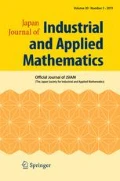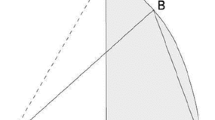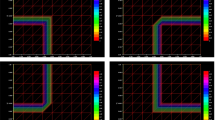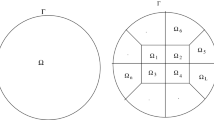Abstract
For the Stokes equation over 2D and 3D domains, explicit a posteriori and a priori error estimation are novelly developed for the finite element solution. The difficulty in handling the divergence-free condition of the Stokes equation is solved by utilizing the extended hypercircle method along with the Scott-Vogelius finite element scheme. Since all terms in the error estimation have explicit values, by further applying the interval arithmetic and verified computing algorithms, the computed results provide rigorous estimation for the approximation error. As an application of the proposed error estimation, the eigenvalue problem of the Stokes operator is considered and rigorous bounds for the eigenvalues are obtained. The efficiency of proposed error estimation is demonstrated by solving the Stokes equation on both convex and non-convex 3D domains.
Similar content being viewed by others
References
Balay,S., Gropp,W.D., McInnes, L.C., Smith,B.F.: Efficient management of parallelism in object oriented numerical software libraries. In E. Arge, A. M. Bruaset, and H. P. Langtangen, editors, Modern Software Tools in Scientific Computing, pages 163–202. Birkhäuser Press, (1997)
Boffi, Daniele, Brezzi, Franco, Fortin, Michel, et al.: Mixed finite element methods and applications, vol. 44. Springer (2013)
Cott,L R S., Ogelius, M V., Scott,L R., Vogelius,M.: Norm estimates for a maximal right inverse of the divergence operator in spaces of piecewise polynomials. ESAIM: Mathematical Modelling and Numerical Analysis, 19(1):111–143, (1985)
Girault,V., Raviart,P-A.: Finite element methods for Navier-Stokes equations: theory and algorithms, volume 5. Springer Science & Business Media, (2012)
Hernandez, V., Roman, J.E., Vidal, V.: SLEPc: A scalable and flexible toolkit for the solution of eigenvalue problems. ACM Trans. Math. Software 31(3), 351–362 (2005)
Kikuchi, F., Saito, H.: Remarks on a posteriori error estimation for finite element solutions. J. Comput. Appl. Math. 199, 329–336 (2007)
Li, Q., Liu, X.: Explicit finite element error estimates for nonhomogeneous neumann problems. Appl. of Math. 63(3), 367–379 (2018)
Liu, X.: A framework of verified eigenvalue bounds for self-adjoint differential operators. Appl. Math. & Comput. 267, 341–355 (2015)
Liu, X.: Explicit eigenvalue bounds of differential operators defined by symmetric positive semi-definite bilinear forms. J. Comput. & App. Math. 371, 112666 (2020)
Liu, X.: Stokes eigenvalue problem. Online scientific computing platform, created on July, Ganjin (2020). https://ganjin.online/xfliu/StokesEigProblem
Liu, X., Oishi, S.: Verified eigenvalue evaluation for the Laplacian over polygonal domains of arbitrary shape. SIAM J. Numer. Anal. 51(3), 1634–1654 (2013)
Nakao, M.T., Yamamoto, N., Watanabe, Y.: A posteriori and constructive a priori error bounds for finite element solutions of the Stokes equations. J. Comput. & Appl. Math. 91(1), 137–158 (1998)
Rump,S.M.: Intlab - interval laboratory. In Tibor Csendes, editor, Developments in Reliable Computing, pages 77–104. Kluwer Academic Publishers, Dordrecht, (1999)
Stenberg, Rolf: Some new families of finite elements for the stokes equations. Numerische Mathematik 56(8), 827–838 (1989)
Verfürth, R.: A posteriori error estimators for the stokes equations. Numer. Math. 55(3), 309–325 (1989)
Watanabe, Y., Yamamoto, N., Nakao, M.T.: A numerical verification method of solutions for the Navier-Stokes equations. Reliab. Comput. 5(3), 347–357 (1999)
Xie, M., Xie, H., Liu, X.: Explicit lower bounds for Stokes eigenvalue problems by using nonconforming finite elements. Jpn. J. Ind. Appl. Math. 35(1), 335–354 (2018)
Zhang, S.: On the divergence-free finite element method for the Stokes equations and the P1 Powell-Sabin divergence-free element. Math. of Comput. 74(250), 543–554 (2004)
Zhang, S.: A new family of stable mixed finite elements for the 3D Stokes equations. Math. of Comput. 74(250), 543–554 (2005)
Author information
Authors and Affiliations
Corresponding author
Additional information
Publisher's Note
Springer Nature remains neutral with regard to jurisdictional claims in published maps and institutional affiliations.
The first author is supported by Japan Society for the Promotion of Science, Grant-in-Aid for Scientific Research (B) 16H03950, 20H01820 and Grant-in-Aid for Scientific Research (C) 18K03411. The second author is supported by Grant-in-Aid for Scientific Research (C) 18K03434. The last author is supported by JST CREST Grant Number JPMJCR14D4, Japan.
The third author is Doctor course student in this affliction when he joined this research.
About this article
Cite this article
Liu, X., Nakao, M.T., You, C. et al. Explicit a posteriori and a priori error estimation for the finite element solution of Stokes equations. Japan J. Indust. Appl. Math. 38, 545–559 (2021). https://doi.org/10.1007/s13160-020-00449-5
Received:
Revised:
Accepted:
Published:
Issue Date:
DOI: https://doi.org/10.1007/s13160-020-00449-5
Keywords
- Stokes equation
- A posteriori error estimation
- A priori error estimation
- Finite element method
- Hypercircle method
- Eigenvalue problem




